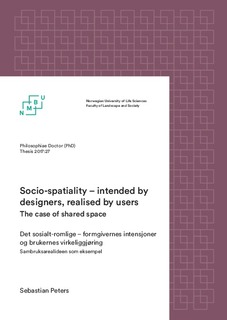| dc.description.abstract | Urban design contributes significantly to the production of public urban space. Socio-spatiality, the dialectic relationship between the social and the spatial, sits at the heart of the field and at the heart of this thesis. Both practice and academia permanently strive to gain more knowledge about and alter this relationship. Accordingly, new urban design ideas focus on mobilising new ways of understanding and influencing socio-spatiality. Yet, the implementation of these ideas depends on making compromises; they have to resonate with prevailing ways of thinking. In the process of adapting them to prevailing thought, their justification gets articulated and their content reframed. The outcome rather reflects pressing policy issues need for practical solutions than innovative thinking about socio-spatiality. Along the way, the intention to mobilise new ways of understanding socio-spatiality is left unattended. Consequently, knowledge about socio-spatiality remains general and elusive.
Therefore, this thesis aims to contribute to more nuanced and firm understanding of socio-spatiality in the context of such innovative urban design ideas. The thesis, consisting of three scientific papers and a synthesising chapter, approaches the problem on two levels. The first is the level of professional discourse about new design ideas: How do professionals adapt ideas that challenge prevailing thought and practice about socio-spatiality to design practice? The second is the level focuses on exploring new ways of understanding the phenomenon of socio-spatiality in built space: How does socio-spatiality unfold in built space designed to produce sociality?
To investigate these questions this thesis explores the case of shared space, framing it as a design idea intending to alter socio-spatiality in urban streets. Shared space is a particularly suitable case for such an investigation because it clearly exemplifies the challenges urban design meets intending to influence socio-spatiality.
The shared space idea gets translated and adjusted in order to adapt it to dominant discourses. Based on the Level One investigation of professional discourse this thesis (Paper One) suggests the concept of domestication to describe and explain this process. I argue that domestication weakens the influence of such ideas, as shared space, that try to mobilise new ways of thinking about urban socio-spatiality. The domestication of shared space is characterised by an overemphasis on technical concerns of implementation and performance, while losing sight of a critical engagement with socio-spatiality.
This is why the second level investigation in this thesis focuses on finding ways to make socio-spatiality of built shared space more clearly conceived and researchable. It explores socio-spatiality in a real life shared space scheme, in Norway, Oslo, St. Olavs plass, where I conducted fieldwork and collected data through street observations, interviews and a survey.
Papers two and three present the findings of using two alternative but compatible approaches to examine socio-spatiality at St Olavs plass, Amin’s situated multiplicity and the Scollon and Scollon’s geosemiotics. Distinct to what professional literature implies, I found socio-spatiality of the investigated shared space to be unstable and lacking homogeneity. Rather, it was characterised by constant change, friction and unpredictability. The main reason is that multiple users constantly change in their composition and in their multiple, often contradictory, interpretations of an ambiguous environment. From these findings, it is plausible that interaction order is more dynamic in shared space than in more strictly regulated and less ambivalent environments. Most shared space design literature does not acknowledge this. Further, the research indicates that people on St Olavs plass try to minimise direct social interaction. This raises doubts regarding claims about shared space as a design means to produce sociality.
The scientific contribution of these findings lies in a more nuanced understanding of socio-spatiality, of particular interest for the urban design field, but also relevant across several other fields of inquiry into the nature of the social in urban space. I hope to offer this nuanced understanding by applying alternative, novel and complementary approaches to understand socio-spatiality. Amin’s situated multiplicity approach has not been used to analyse socio-spatiality in a real world setting before. Geosemiotics do not only complement this operationalisation of Amin’s theoretical concepts. They present a more straightforward way of empirically engaging with socio-spatiality, making it more researchable. In addition, the geosemiotic investigation of St Olavs plass is a contribution to the scientific field of social semiotics. It adds a particularly clear case to the existing corpus of semiotic studies, of a design that explicitly aims to influence how people make meaning of and react to urban space.
For urban designers, particularly those working with concepts like shared space, there is much to learn from St Olavs plass. The square allows for socio-spatiality to change and adjust to the prevailing needs of different users, who become active participants in this process. This puts a new perspective on shared space, contrasting with existing accounts but not necessarily in a negative sense. It offers a new kind of knowledge for professionals who work with shared space, and may encourage them to attend stronger to socio-spatiality in debates, about shared space in particular, but also more generally in the urban design field.
The production of urban space continues, and urban design plays a key role in this enterprise, as a profession and as an academic field. Yet an elusive understanding of socio-spatiality leaves practice poorly equipped for its interventions into socio-spatiality and ideas that aim to mobilise a more nuanced understanding get domesticated and simplified by dominant discourses. The elusiveness of urban design’s knowledge of socio-spatiality may itself be one of the reasons for this domestication. Therefor it matters that both scholars and practitioners pay attention to this dialectical relationship, in the context of implementing innovative ideas. This is where this thesis makes its overall contribution: exploring different theoretical and methodological approaches to learn about and suggest new ways of investigating and working with socio-spatiality. | nb_NO |

